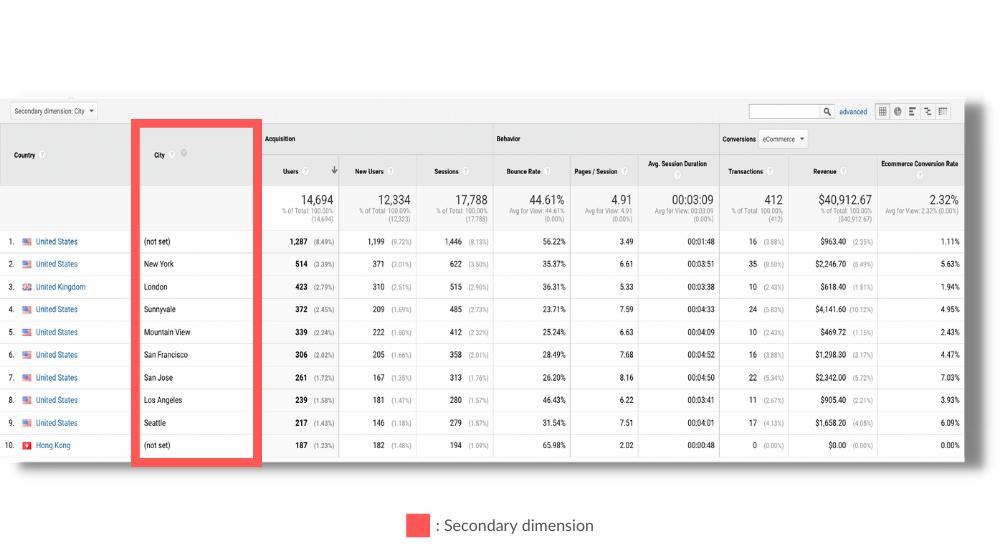Introducing the Intricacies of Second Measurement in Google Analytics: a Comprehensive Guide on Just How It Functions
Navigating the intricate realm of second dimensions in Google Analytics is a task that calls for a keen understanding of exactly how this attribute operates within the system. As electronic landscapes develop and data comes to be increasingly vital for decision-making, understanding the nuances of second dimensions can be the secret to opening valuable insights. From establishing reports to diving into sophisticated techniques, the journey to using the power of second measurements is both difficult and rewarding. Join us as we check out the ins and outs of this device and find how it can transform your data evaluation strategies.
Fundamentals of Second Dimension in Google Analytics
When assessing information in Google Analytics, using the additional measurement feature provides useful insights right into the efficiency of different metrics. The additional dimension allows customers to further explore their data by including an extra layer of info to their primary dimensions. By doing so, analysts can acquire an extra thorough understanding of the factors influencing their web site's efficiency.
In Google Analytics, the main dimensions stand for the major categories of data, such as web traffic sources or tools. When a secondary dimension is applied, it provides a deeper degree of granularity by revealing another facet of the information within the picked key measurement. As an example, if the primary dimension is 'Website traffic Source,' including a secondary dimension like 'Landing Page' can reveal which specific web pages are driving web traffic from each resource.
This function is specifically beneficial for identifying patterns, connections, and patterns that might not be right away apparent when checking out the data from a single dimension. By leveraging the second dimension in Google Analytics, customers can reveal important insights that can inform strategic decisions and optimizations to enhance web site efficiency.
Establishing Additional Measurement Reports
Expanding on the understandings obtained with the use of secondary measurements in Google Analytics, the process of setting up additional measurement reports entails setting up extra layers of data to better boost the deepness of analysis. Once the main record is picked, users can click on the "Secondary dimension" tab located above the information visualization location. From there, a drop-down food selection will certainly show up, providing a myriad of options to choose the second measurement that ideal enhances the key information set.
Leveraging Second Measurements for Insights
Making use of second dimensions in Google Analytics offers a strategic approach to extracting nuanced understandings for educated decision-making in on the internet company optimization. By combining primary dimensions with additional measurements, businesses can dive deeper into their information to reveal beneficial connections and patterns that may not be right away evident. By segmenting internet site traffic by geographical place (primary dimension) and after that including a secondary dimension like device classification, organizations can identify if particular areas like accessing the site using mobile or desktop.
In addition, leveraging secondary measurements enables learn this here now organizations to acquire a much better understanding of user actions and preferences. Evaluating conversion rates based on website her latest blog traffic sources (primary dimension) along with the second measurement of touchdown web pages can disclose which details pages are most effective in driving conversions for organic search web traffic versus social media web traffic. These insights can then notify advertising and marketing methods and web site optimization initiatives to boost overall efficiency and maximize ROI.
Advanced Methods for Secondary Dimensions
To better remove elaborate understandings and boost data-driven decision-making within Google Analytics, executing advanced strategies for using second dimensions is essential in unlocking much deeper layers of important info for company optimization. One sophisticated method is using custom measurements and metrics, enabling the monitoring of specific individual interactions or actions that are not recorded by default in Google Analytics. By defining and implementing customized measurements, businesses can customize their monitoring to line up with unique service goals and objectives.
An additional sophisticated method includes making use of filters in conjunction with second measurements. Filters make it possible for users to refine the information showed in Google Analytics reports, giving more targeted and relevant understandings. By using filters strategically with additional dimensions, services can segment data extra successfully, causing a more clear understanding of customer behavior and performance metrics.

Optimizing Information Evaluation With Second Dimensions

In addition, optimizing information evaluation with secondary dimensions includes explore various mixes to determine patterns and relationships that may not be promptly evident. This iterative strategy allows analysts to fine-tune their reporting and concentrate on one of the most pertinent data points for their organization objectives. Eventually, by leveraging additional dimensions successfully, experts can boost the precision and performance of their data analysis efforts in Google Analytics.
Conclusion
Finally, understanding the complexities of additional measurements in Google Analytics is essential for obtaining much deeper understandings into internet site efficiency. By establishing up secondary measurement reports, leveraging them for understandings, and utilizing advanced strategies, analysts can optimize data analysis and make educated choices. This thorough overview has actually provided a thorough overview of exactly how additional measurements work and their significance in boosting the logical capabilities of Google Analytics customers.
The second measurement permits users to additionally explore their data by adding an extra layer of info to their main measurements. When a secondary measurement is used, it provides a much deeper level of granularity by revealing another element of the information within the selected main measurement.Increasing on the insights gained via the utilization of secondary dimensions in Google Analytics, the procedure of setting up additional dimension records entails setting up added layers of data to additionally improve the depth of evaluation. By incorporating primary measurements with additional measurements, services can delve much deeper into their data to discover important relationships and patterns that may not be quickly obvious. One method to maximize information evaluation with secondary measurements is to incorporate them with key measurements to obtain a more comprehensive view of website efficiency.